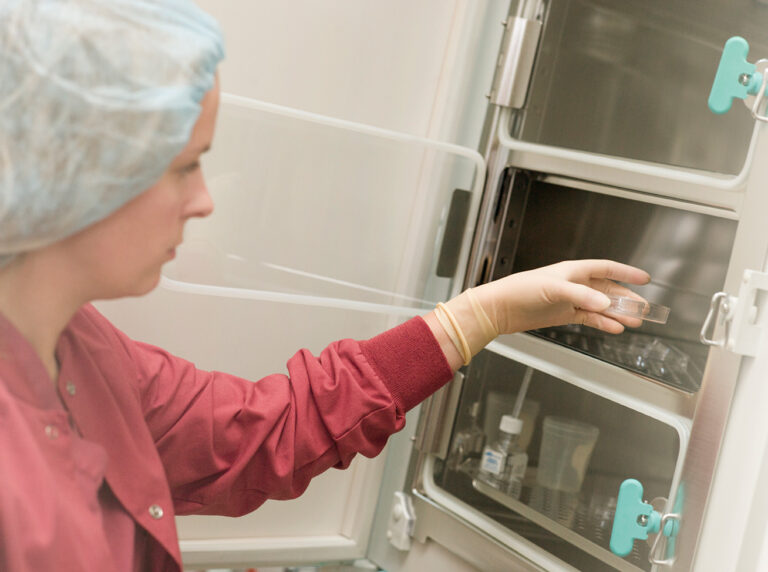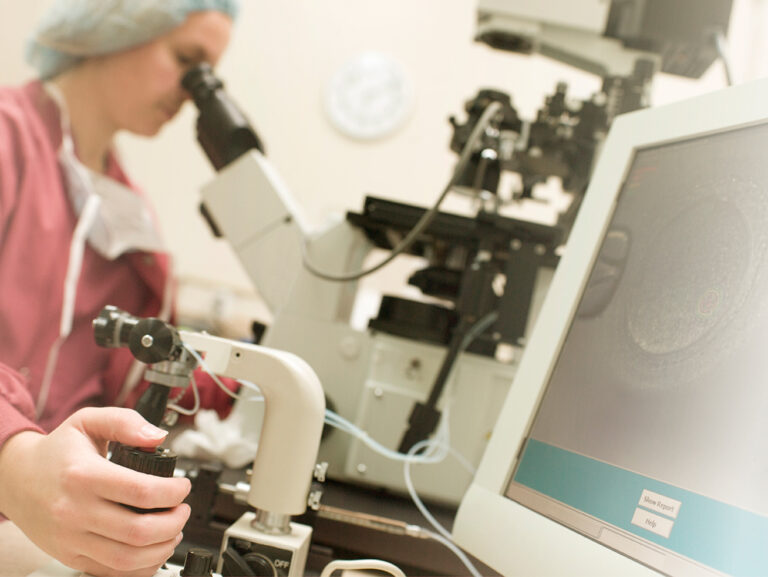In Vitro Fertilisation (IVF) / ICSI
The miracle of life happens in our laboratories.


What does it consist of?
Fertilization is done with a technique called ICSI (Intracytoplasmic sperm injection). So, our embryologists select the best sperm and inject them one by one directly into each egg. It is a very precise technique that allows to increase the possibilities of fertilization of the ovules.
Depending on the origin:
- IVF with couple sperm. Sperm come from a seminal sample of the patient’s partner.
- IVF with donor sperm. The sperm comes from a gamete bank.

When is it indicated?
- Injury or absence of the fallopian tubes.
- Severe alterations in sperm quality
- Use of testicular sperm (TESE)
- Previous failures of previous treatments.
- Hereditary genetic disease (PGT-M)
- Need for Pre-implantation Genetic Diagnosis (PGT-A).
- Use of vitrified oocytes after fertility preservation
- ROPA
- Others
Ovarian stimulation
Treatment begins with ovarian stimulation of the woman. To do this, drugs are used that enhance the development of follicles (where future eggs mature). Normally, a woman only matures one egg in each menstrual cycle, while in this way several mature eggs can be obtained in a single cycle. The medication is administered subcutaneously, with “auto-injection” devices.
Control of follicular development
During the treatment of ovarian stimulation, we will perform regular controls, by vaginal ultrasound and if necessary, hormonal analysis; all this to check follicular maturation and schedule the ideal time for puncture. This phase lasts between 10 and 12 days.
Puncture
The removal of the eggs is a very simple procedure that is performed in the operating room, by means of the vaginal puncture guided by ultrasound and the aspiration of the follicles. The process does not last more than 15 minutes and is performed under sedation for your comfort and well-being.
It does not require hospital admission, only a rest of several hours is prescribed in the room of our clinic. After this time, you can resume your usual activity.
Preparation of the seminal sample
It is necessary to prepare the semen sample so that it has the ability to fertilize the egg, in addition to achieving an optimal concentration of mobile sperm.
The semen sample is obtained by the male by simple masturbation, in our center, the same day of the insemination or can be previously cryopreserved. In cases where the use of donor semen is indicated, this sample will always be frozen and stored in our semen bank. In both cases, our biologists will treat it in the laboratory with a process known as sperm training, so that we can select the sperm with the best mobility.
Fertilization and culture
Our embryologists perform fertilization through a technique called ICSI (Intracytoplasmic sperm injection). It consists of the selection of a single sperm for each egg that is microinjected into it. It is a very precise technique that favors the fusion of the nuclei of the male gamete with the female. Fertilized embryos must be kept in culture for 5-7 days. And during this time, they will develop until they reach the blastocyst stage.
In Next Fertility, we use time-lapse technology, which allows real-time monitoring of the evolution of embryonic development. In this way, we evaluate in a very exhaustive way the morpho-kinetic changes that take place and this allows us to select the embryos most likely to get a pregnancy.
Embryo Transfer
In the embryo transfer we will deposit the embryo inside the uterine cavity; this can be done in “fresh” or in “deferred”. The transfer is done with an embryo in blastocyst stage (5-7 days of embryonic life), is called in “fresh” when it is done with a blastocyst without having been frozen previously, during the same cycle of ovarian stimulation and follicular puncture; and in “delayed” when a thawed blastocyst is transferred, in a cycle after the in vitro fertilisation treatment cycle.
The transfer is made “deferred” when: a) there is a risk of “Ovarian hyperstimulation syndrome”, b) endometrial conditions are not adequate for embryonic implantation, c) it is necessary to perform embryonic genetic diagnosis techniques, d) there is some reason why gestation in the same IVF cycle is not advisable.
In both cases, the transfer is done with a transfer tube or catheter, using an ultrasound guide. This procedure is completely painless and does not require hospital admission.
Pregnancy Test
After the “beta-waiting” period (14-15 days after insemination), a blood pregnancy test will be done. We will look for the presence of the hormone β-hCG (human chorionic gonadotropin), which is the hormone produced by the embryo after its implantation in the endometrium.
If the beta test was positive, two weeks later we will perform an ultrasound, to confirm the presence of “gestational sac” inside the uterus and observe the heartbeat of your future baby.
Do you have more questions? We will be delighted to assist you.
We finance 100% of your treatment. Get in touch with us and we will solve all your doubts about our treatments, techniques and promotions.



